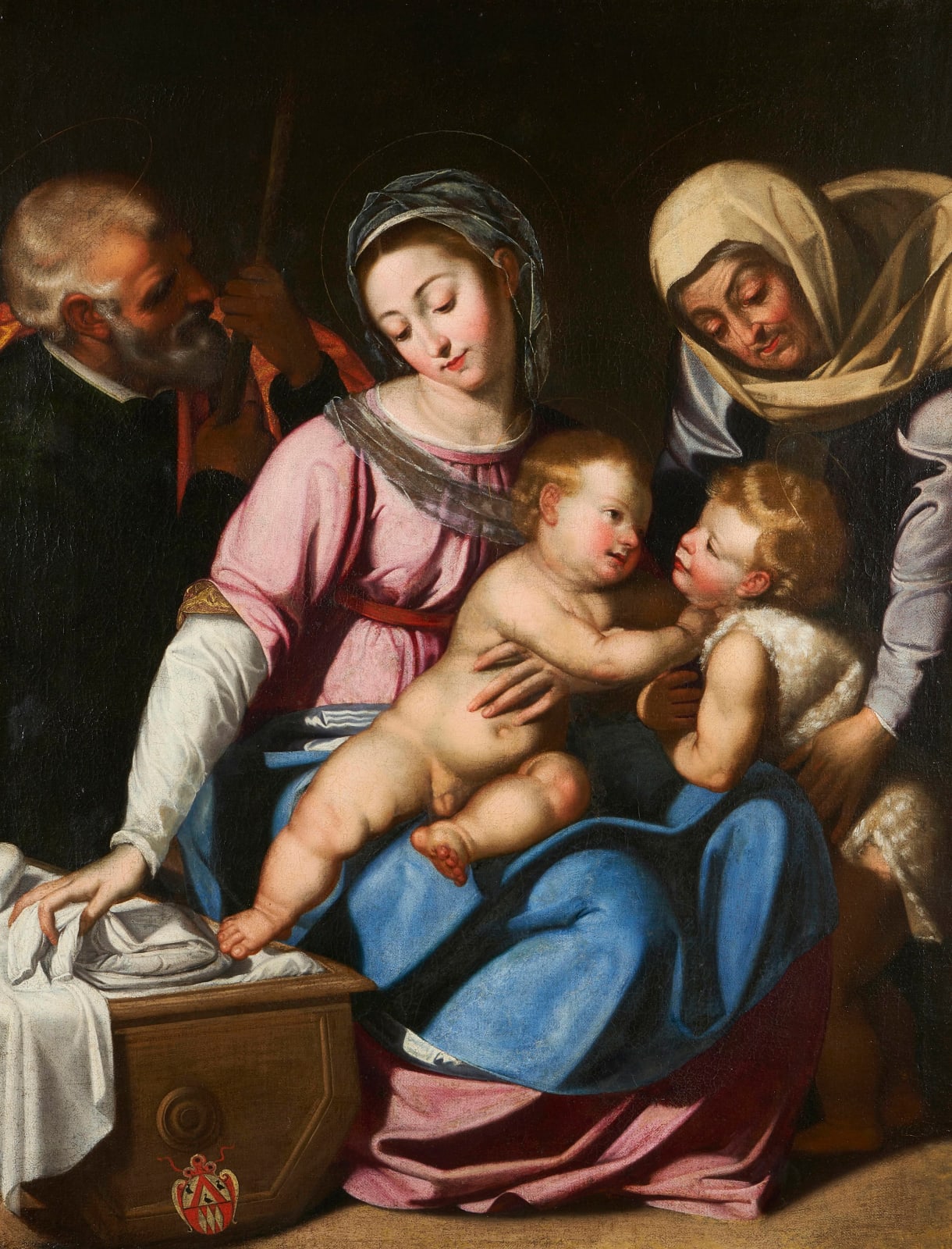Scipione Pulzone, called Il Gaetano (Gaeta 1544 - Rome 1598)
Holy Family with the Young St John The Baptist and St Elizabeth
Oil on canvas
51 x 39 in
129.5 x 99.1 cm
129.5 x 99.1 cm
Scipione Pulzone, known as "Il Gaetano" after his birthplace of Gaeta, was a prominent Italian painter of the late Renaissance and early Baroque period. Active primarily in Rome, he was a leading exponent of the refined and highly detailed Mannerist portraiture that characterised the late 16th century.
Born in 1544 in Gaeta, a coastal town in Naples, Pulzone received his artistic training in Rome. He was a pupil of Girolamo Siciolante da Sermoneta, a mannerist painter known for his balanced compositions and delicate treatment of figures. Pulzone quickly distinguished himself with his technical mastery, particularly in portraiture, gaining recognition for his meticulous realism and elegant rendering of textures and details.
Pulzone's artistic style is characterised by an extraordinary precision in rendering surfaces, fabrics, and physiognomic details, reflecting an influence from both the Roman Mannerist tradition and the naturalistic tendencies that foreshadowed the Baroque. His work often exhibits an ethereal clarity, with luminous flesh tones and refined, almost miniaturistic detailing in clothing and accessories. His portraits, which include depictions of popes, cardinals, and aristocrats, are notable for their psychological depth and their ability to capture the social status of his sitters.
Pulzone was deeply influenced by the religious and artistic climate of Counter-Reformation Rome. His devotional paintings reflect the ideals promoted by the Council of Trent, favoring clarity, piety, and emotional engagement over the artificial complexity of earlier Mannerism.
Pulzone's reputation as a portraitist led him to receive commissions from some of the most powerful figures of his time. Among his most famous portraits are those of Pope Gregory XIII, Cardinal Ferdinando de' Medici, later Grand Duke of Tuscany, Eleonora de' Medici, among many others. In addition to portraits, Pulzone painted significant religious works, including The Immaculate Conception (Church of Gesù, Rome).
Pulzone’s work played a crucial role in bridging the transition from the elegance of Mannerism to the more naturalistic tendencies of the early Baroque. His meticulous approach to portraiture influenced later painters, including Caravaggio, whose realism and psychological depth can be seen as a further evolution of Pulzone’s refined style. His religious paintings, with their clear, idealized figures, contributed to the artistic language of Counter-Reformation sacred art.
Despite being somewhat overshadowed by later Baroque masters, Pulzone remains an important figure in late 16th-century Italian art. His works continue to be studied for their technical excellence and their role in the development of portraiture and religious painting in Rome.
Born in 1544 in Gaeta, a coastal town in Naples, Pulzone received his artistic training in Rome. He was a pupil of Girolamo Siciolante da Sermoneta, a mannerist painter known for his balanced compositions and delicate treatment of figures. Pulzone quickly distinguished himself with his technical mastery, particularly in portraiture, gaining recognition for his meticulous realism and elegant rendering of textures and details.
Pulzone's artistic style is characterised by an extraordinary precision in rendering surfaces, fabrics, and physiognomic details, reflecting an influence from both the Roman Mannerist tradition and the naturalistic tendencies that foreshadowed the Baroque. His work often exhibits an ethereal clarity, with luminous flesh tones and refined, almost miniaturistic detailing in clothing and accessories. His portraits, which include depictions of popes, cardinals, and aristocrats, are notable for their psychological depth and their ability to capture the social status of his sitters.
Pulzone was deeply influenced by the religious and artistic climate of Counter-Reformation Rome. His devotional paintings reflect the ideals promoted by the Council of Trent, favoring clarity, piety, and emotional engagement over the artificial complexity of earlier Mannerism.
Pulzone's reputation as a portraitist led him to receive commissions from some of the most powerful figures of his time. Among his most famous portraits are those of Pope Gregory XIII, Cardinal Ferdinando de' Medici, later Grand Duke of Tuscany, Eleonora de' Medici, among many others. In addition to portraits, Pulzone painted significant religious works, including The Immaculate Conception (Church of Gesù, Rome).
Pulzone’s work played a crucial role in bridging the transition from the elegance of Mannerism to the more naturalistic tendencies of the early Baroque. His meticulous approach to portraiture influenced later painters, including Caravaggio, whose realism and psychological depth can be seen as a further evolution of Pulzone’s refined style. His religious paintings, with their clear, idealized figures, contributed to the artistic language of Counter-Reformation sacred art.
Despite being somewhat overshadowed by later Baroque masters, Pulzone remains an important figure in late 16th-century Italian art. His works continue to be studied for their technical excellence and their role in the development of portraiture and religious painting in Rome.
Join our mailing list
* denotes required fields
We will process the personal data you have supplied in accordance with our privacy policy (available on request). You can unsubscribe or change your preferences at any time by clicking the link in our emails.
